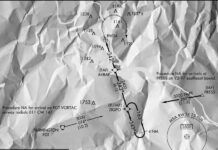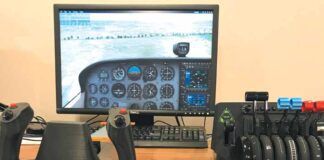In the far reaches of the Upper Midwest, an island vacation can mean you’re heading north. Way north. Yes, there are islands in Wisconsin and Michigan, even some with sandy beaches. The sunsets are amazing. But don’t expect any palm trees, and bring your rain gear. Like most islands, you’ll arrive by ferry or by air, but this isn’t a boating magazine.
Beaver Island, Michigan, the largest blob in a small archipelago, is 13 miles long and six miles wide. It’s only 40 nm from the more-famous Mackinac Island. You’ll want to spend some extra time planning the possible arrival routes—all of them—with the island sitting smack in the middle of upper Lake Michigan. Ignoring the water hazard, this scenic tour of northern Lake Michigan makes the perfect summertime trip. Just know that lake fog and cool, stratus-cloud days with rain are common up there even in the warmest months, so be prepared to file.
The Options
Say you’re flying to Beaver Island, KSJX, for a weekend lighthouse tour in your Cirrus. You’re starting from Chicago and haven’t yet decided whether to arrive from the lower-Michigan side or the Wisconsin side. With concern for the open water, your examination of the approach should leave you puzzling over how to plan it with a decent safety margin.
“The approach?” There are NDB 27 and RNAV (GPS) 27 approaches, but the NDB offers no advantages so we’re stuck with the sole RNAV procedure. The airport has three runways, one of which is paved and comfortably long enough for light aircraft. The other two runways are turf and, while 14/32 at 3278 feet is adequate for the SR20, 5/23 is 2054 feet, which might be rather exciting.
If you were to start the approach from the shoreline at the Pellston VOR, it’s 37 nm to Runway 27, most of it over the lake. While the beginning and ending portions are over land, the distance and altitude over water make this a potential sphincter-tightening experience.
If you want to go see Mackinac Island first, you’d fly to Beaver Island from the northeast via DIPLE. But it would be in your best interest to avoid extra time over the water and skip DIPLE and just request direct to BODAY. And were you to come from the west, Upper Michigan or Wisconsin, you’re looking at close to 100 nm over water to get to BODAY. Although that’s a long way, you could mitigate some of that over-water risk by staying high. Then, there’s that procedure turn course reversal requiring a few extra minutes—which could seem like hours at 2600 feet—over the water.
Safe? Only you can decide. Are you comfortable with long water crossings? Some pilots are; some aren’t. Those who cross the lakes often know how high they want to fly. They’ll also carry emergency equipment such as life jackets, rafts, and personal locator beacons. (Flights for-hire require approved flotation gear per 14 CFR 91.205.) Regardless, the prudent pilot will fly as high as possible, calculate glides, point of no return and time out of glide range, and they’ll only go when the weather permits the shortest route. Some might only cross the lake in July and August, when the water is warmest.
The What-Ifs
So, our best option is using the IAF at Pellston, a total of 32.1 nm from the initial to the final fix. The approach can be flown as low as 2600 feet. Over-water distance is about 17.6 nm. In the SR20, what altitude would be a comfortable hedge against engine failure or fire?
Let’s take a closer look at that final. The runway is about 2.5 nm inland on the approach. The FAF AMILE is 5.9 miles from the runway, of which 3.4 miles is over water.
It’s worth a look at the maximum glide criteria in the POH. Using the published altitudes and the 9:1 glide ratio, let’s examine AMILE. Assuming the island is flat (it’s not) our reference for the ground elevation is the airport at 669 feet, so you’re roughly 2000 feet above the island at AMILE. From 2000 feet, your power-off glide is about three miles. You’d get wet. What would it take to stay dry? You’d need to be able to glide 3.4 miles, requiring about 2300 feet above the ground or about 2900 feet MSL at AMILE, still comfortably in the “normal maneuvers” range.
BODAY is about 12.4 nm from the runway and about nine miles from land. The book tells you that at 6000 feet you’d glide about nine miles. So, that would allow you to stay dry with an engine failure at BODAY, but if you’re planning not less than 6000 feet at BODAY you’ll still need to reach AMILE by 2900 feet. That’s a loss of 3100 feet in 6.5 miles. At a gentle three miles per thousand feet you’d need almost 10 miles. But the glide chart says you’d descend 3100 feet in about 4.7 miles, power off. So, while a decent of 3100 feet in 6.5 miles might be uncomfortable, it’s still fully controlled, requiring a bit power.
Windy? Circling minimums are the same so there’s no penalty to circle if you don’t mind landing on turf. However, in the IAP NOTAMs (You check those, right?) you’ve got this chart note: “Circling not authorized to RWYS 5, 14, 23, 32.” This leaves Runway 9. So unless it’s an emergency, treat it like a one-runway field for IFR purposes. Miss? Well, it’s back to BODAY and, given our analysis, you should ask for something above 6000 feet.
Island Flying
Beaver Island is a typical example of over-water approach scenarios—although rare for the Midwest—that speaks to what you should consider when flying into any island. A few minutes over the big lake will give us pause, as well it should. We just did all this planning at our desk at home, poring over the charts, the POH and used a little trigonometry, all to figure out how to maximize our potential to stay out of the water if we lose power. All that planning—and that nice airframe parachute—notwithstanding, flying to an island raises the specter of a potential ditching and safe evacuation still warrants flotation devices.
So if you’re planning a trip that includes over-water approaches and departures, take the time to study all the options and figure out what your airplane can and cannot do to increase the safety margins. Get the extra equipment. You’ll be more likely to enjoy your trips to little gems like Beaver Island.
Elaine Kauh is a CFII in eastern Wisconsin. Her idea of an island vacation is ice fishing from a northwoods bay in January.




